Delidding The AMD Ryzen 5 2400G APU: How To Guide and Results
by Gavin Bonshor on May 10, 2018 8:00 AM EST- Posted in
- CPUs
- Guides
- APUs
- Ryzen
- Ryzen 3 2200G
- Ryzen 5 2400G
- Delidding
- Delid
Delidding The Ryzen 5 2400G Results and Conclusion
There has been a lot of hype since the launch of the Ryzen 2000 series APUs and in our Ryzen 5 2400G review, it’s noted that in multiple scenarios they outperform the competing Intel counterparts second to none in pixel rendering tests such as gaming, mainly thanks in no small part to the integrated iGPU featuring Vega cores. The aim of today’s testing with our best Ryzen 2000 series APU from a purely CPU frequency-based standpoint was to ascertain whether delidding makes a noticeable improvement to thermal performance, as well as determining if any extra headroom in CPU core frequency is made available.
As per our regular motherboard testing methodology when we find the max stable overclock, testing was done following the same procedure. Following on from the testing done in our Ryzen 2000 series APU overclocking guide, the aim in this was to continue with simple overclocking to push the core frequency.
To start, here are our initial overclocking results with the retail chip as sold:
After delidding the chip, replacing the paste with a liquid metal TIM, we achieved the following results:
Not only are the thermal properties improved from delidding and having the IHS slavered up with Thermal Grizzly Conductonaut liquid metal compound but operating at the previously unstable frequency of 4.2 GHz was made possible after delidding. Even at 4.2 GHz with the 2400G delidded, the temperatures hit the same levels as 4.0 GHz non delidded which is quite impressive. Even more monumental was the system managed to boot into Windows 10 at a clock speed of 4.3 GHz, although the system wouldn’t just hang when OCCT was fired up, it would crash completely meaning that even with a good AIO CPU cooler and being de-lidded, no more than 4.2 GHz was stable with this particular chip.
The best way to represent some of this data is in graphs. First up is the main one, temperature:
This is a clear representation showing the decrease in CPU temperature after the delidding process. The higher the frequency, the bigger the overall difference!
For power consumption, there was almost zero difference. This is to be expected: the chip will still consume the same amount of power with a standard temperature window. The cooler still has to remove the heat energy, however it is now being transferred better to the cooler through the new TIM.
The interesting result here is POV-Ray. We use POV-Ray in our overclock testing as it is usually very good if there are cache and memory errors associated with the high frequency. However here we see that beyond about 3.8 GHz, the retail processor has trouble getting more performance at a higher frequency, likely due to the CPU reaching thermal limits and the frequency mechanisms having to compensate. The end result is 'sustained' performance at higher frequencies. Due to the delid process, this was not an issue through to 4.2 GHz. Having the extra thermal headroom ultimately gave both more frequency and better sustained performance.
Is Delidding the Ryzen 2400G Worth it? Risk Versus Reward
As previously stated, the primary use where I could see delidding a Ryzen 2000 series APU viably applicable would be in a situation where cooling restrictions are in place such as a small form factor system or a HTPC. The benefits of the reduction in temperature would allow for a more svelte and slim line cooler to be used without pushing towards the maximum operating temperature.
Another less but pertinent use would be for performance users wanting faster clock speeds, although at a cost of voiding the warranty, potentially damaging and killing the chip itself during the process, and the added cost of the tools, it could be a price too much in retrospective which could be spent on a better CPU to begin with. Some vendors in the EU such as Caseking are actually selling pre-delidded Ryzen 3 2200G and Ryzen 5 2400G chips with their own warranties at an additional cost, which is often a better idea than manually performing the process and shelling out for the extra tools. That’s all good, providing this option is available to the user, although so far, I have yet to be able to find a large vendor offering this service in the US.


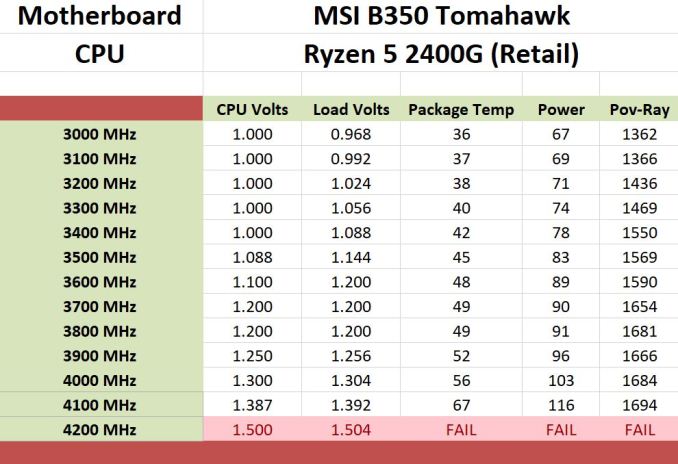
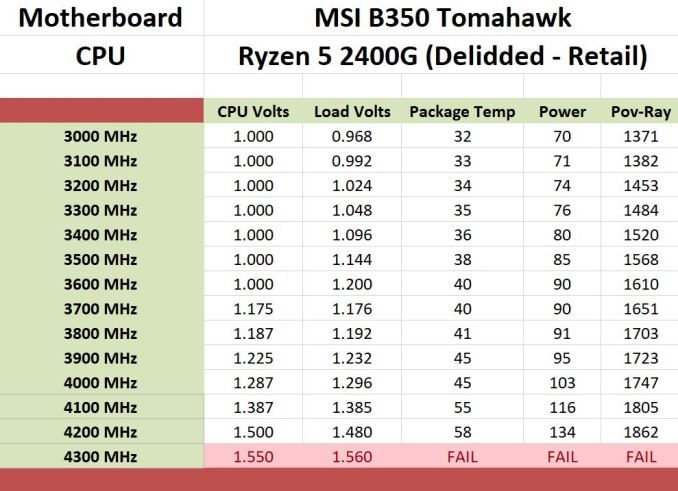
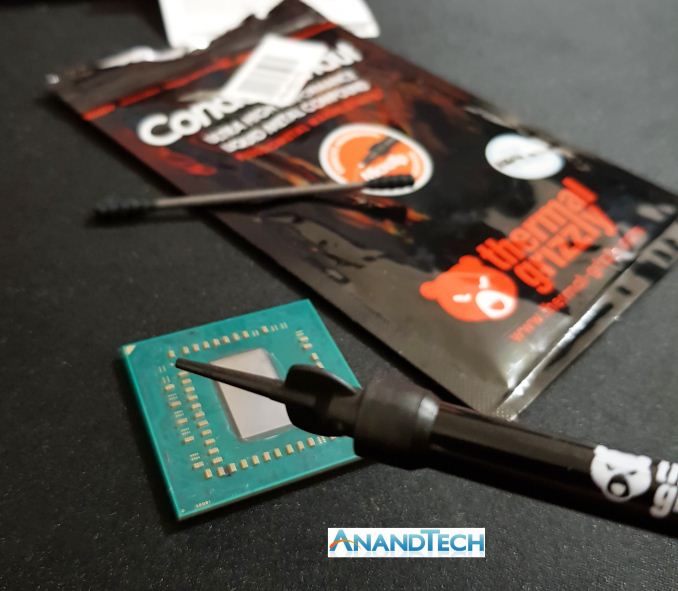
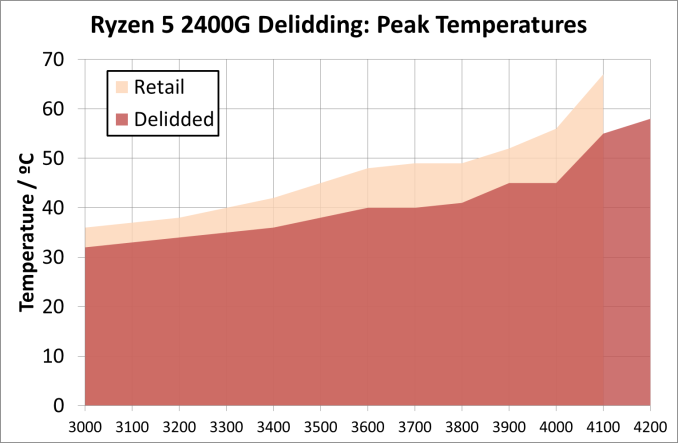

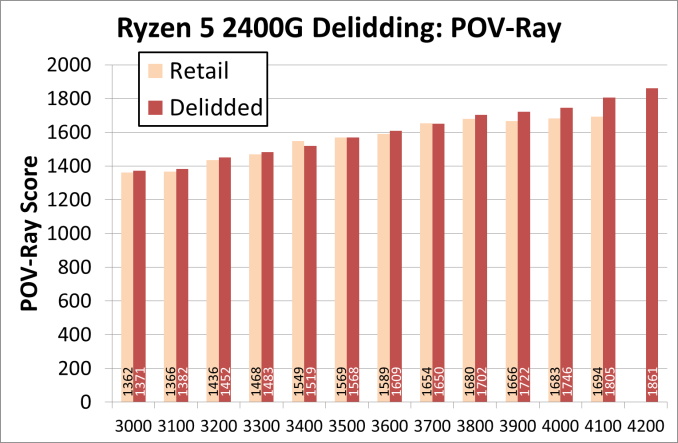








73 Comments
View All Comments
sonny73n - Thursday, May 10, 2018 - link
Isnt the sole purpose of delidding is to reduce temp and improve performance? It’s quite different from modding a car.How about a blade which costs only 20 cents.
Lord of the Bored - Friday, May 11, 2018 - link
A lot of car mods are dedicated to improving performance. Just like building a PC, there's more to a car than adding RGB LEDs.sonny73n - Saturday, May 12, 2018 - link
You’ve never modded a car, have you? I wouldn’t spend more than 10% of that $10k on a $2k car’s engine, unless you mod a lemon.eastcoast_pete - Thursday, May 10, 2018 - link
Yes and no; a key reason why I am even considering a 2400G is that, once you have a 1700 or 2700, you still need a dedicated GPU, and that means an extra $120 - $150 for an underwhelming dGPU (geforce 1030), all better ones being way overprized thanks to the crypto-craze. Also, the delidding tool doesn't wear out (buy once, delidd many), so my plan would be to borrow or rent it from someone for a fraction of the cost, or buy one and resell it for $10 less after I am done. That leaves the costs for the conductonaut, which won't break the bank. Overall, still a good value proposition to get through the cryptomining dGPU price craze.werpu - Wednesday, May 16, 2018 - link
The 2400 is suitable for many situations, but for my desktop 4 cores 8 threads was not enough... Usually you have the graphics card already. I am considering going for a 2400g however later this year for a homegrown nas. This littly processor provides enough power to run vms decently a thing which most commercial home nases are not able to pull off decently due to their underpowered processors.boozed - Thursday, May 10, 2018 - link
A very valid point, which is addressed in the article's final paragraph.Diji1 - Friday, May 11, 2018 - link
I've never done it but there are delidding services available apparently which presumably cost less than buying the tool to do the delidding.VoiceOfReason116 - Thursday, May 10, 2018 - link
Gavin mentioned that he didn't know of large vendor offering pre-delidded processors in the US. I believe that Silicon Lottery does this, though they may not offer this service for AMD processors. They also do binning of CPUs. From the little bit I've heard, people speak pretty highly of them.Oxford Guy - Thursday, May 10, 2018 - link
Probably a stealth subsidiary of Intel.Oxford Guy - Thursday, May 10, 2018 - link
"a direct soldering has the best performance but might not withstand mulitple years of cycling."Bogus FUD. That concern only applies to liquid nitrogen or a similar extreme.
People have been recycling a slipshod PDF "article" with that concern-trolling nonsense for years now, pretending that it applies to normal cooling methods like water and air. Intel marketing at its finest. In an alternate marketing universe, AMD's use of solder is a mistake because it's more convenient to delid polymer TIM parts. And, in this fantasy zone, indium solder doesn't yield enough performance.
"standard TIM 'goop/paste' has sufficient longevity but lower performance"
Lower performance than what? There is a wide enough range among polymer TIM alone, without comparing the best polymer TIMs to the best indium solders. This is one of the reasons people weren't pleased when Intel marketed Devil's Canyon on the basis of a new-and-improved polymer TIM but an enthusiast website's testing found that not only did it have the identical low performance of its predecessor, it was outperformed by a rather inexpensive 3rd-party polymer TIM. The US government exposed Arctic Silver 5 for having a paltry thermal transfer rate when compared with its company's claimed rate. The 3M polymer TIM, by contrast, performed exactly as advertised (much better than Arctic Silver 5).
"I could see delidding a Ryzen 2000 series APU viably applicable would be in a situation" where rich people have nothing better to do with their time and money.